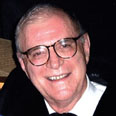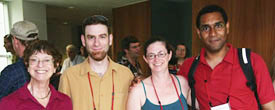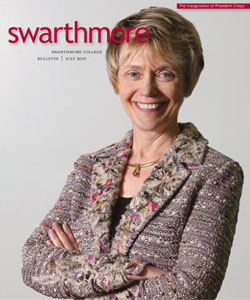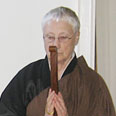Features
A Historic Day for Swarthmore
By Carol Brévart-Demm
 SWARTHMORE COLLEGE MADE HISTORY THIS YEAR.
SWARTHMORE COLLEGE MADE HISTORY THIS YEAR.
On May 8, a blustery spring day, the College inaugurated its 14th president. With 13 having gone before since 1865, this new president might have seemed to be just one among many. But this time, strong winds of change were blowing—literally, judging from the way the trees in the amphitheater were swaying in time to the wind’s celebratory song. On this day, after two Edwards, two Williams, and one each of Charles, Joseph, Frank, John, Courtney, Robert, Dorrie, David, and Alfred, Swarthmore College added the name Rebecca to its list of College presidents.
Yes—as chair of the Board Barbara Mather said in her welcome speech—Swarthmore’s 14th president, Rebecca Chopp, “happens to be a woman.”
DURING THE INAUGURAL CELEBRATION with the theme “Hope in an Age of Clamor: Leadership, Liberal Arts, and the Common Good,” hundreds of visitors and members of the campus community were treated to two days of cultural and intellectual events. The evening before the installation ceremony, crowds flocked to the Lang Performing Arts Center’s Pearson-Hall Theatre to watch “A Celebration of Community.”
Features
Meticulous Intensity
By Robert Strauss
 The 45-year-old man looked quite rested on the operating table, almost as if he were a character from a cop flick. He was wearing white Nike sneakers, navy blue sweatpants from Old Navy, and a long-sleeved sweatshirt with a Nike logo.
The problem was, the guy was, in fact, dead—one of dozens of dead folks who lie on that operating table every year, ready to be examined by Dr. Fredric “Rick” Hellman.
The 45-year-old man looked quite rested on the operating table, almost as if he were a character from a cop flick. He was wearing white Nike sneakers, navy blue sweatpants from Old Navy, and a long-sleeved sweatshirt with a Nike logo.
The problem was, the guy was, in fact, dead—one of dozens of dead folks who lie on that operating table every year, ready to be examined by Dr. Fredric “Rick” Hellman. Related Article
Features
Let's Talk About It
By Laura Markowitz ’85
 On a sunny Monday in April, opposite the doors of Parrish Hall, a group called Students for Peace and Justice in Palestine (SPJP) erected a 10-foot tall fence covered in black plastic. With a narrow opening at its center, topped with barbed wire, it mimicked an Israeli checkpoint. People who wanted to experience the mock checkpoint were stopped and searched by students wearing t-shirts labeled “IDF” or “International Observer.” Some were allowed through; others were arbitrarily refused entrance. The first part of a series of events and discussions called “Three Days in Palestine,” it was intended to raise awareness of the plight of Palestinians in Israel and the occupied territories. Not surprisingly, it also provoked a host of reactions, some of them quite negative. Yet, postings on the student online Daily Gazette—where campus debates seem to be aired these days—were mostly respectful and thoughtful.
On a sunny Monday in April, opposite the doors of Parrish Hall, a group called Students for Peace and Justice in Palestine (SPJP) erected a 10-foot tall fence covered in black plastic. With a narrow opening at its center, topped with barbed wire, it mimicked an Israeli checkpoint. People who wanted to experience the mock checkpoint were stopped and searched by students wearing t-shirts labeled “IDF” or “International Observer.” Some were allowed through; others were arbitrarily refused entrance. The first part of a series of events and discussions called “Three Days in Palestine,” it was intended to raise awareness of the plight of Palestinians in Israel and the occupied territories. Not surprisingly, it also provoked a host of reactions, some of them quite negative. Yet, postings on the student online Daily Gazette—where campus debates seem to be aired these days—were mostly respectful and thoughtful. Features
Lesson for Reform
By Stephen Davidson ’61
 President Barack Obama’s successful effort to enact a health care reform bill was widely seen as a triumph of policy, and it is hard to overstate the historic nature of the achievement. But any assessment of the legislation that emerged from the yearlong effort is best made through a political lens. The story of health care reform in the United States—and, indeed, almost any major policy issue—is fundamentally a story of our politics.
President Barack Obama’s successful effort to enact a health care reform bill was widely seen as a triumph of policy, and it is hard to overstate the historic nature of the achievement. But any assessment of the legislation that emerged from the yearlong effort is best made through a political lens. The story of health care reform in the United States—and, indeed, almost any major policy issue—is fundamentally a story of our politics. Features
Ready to Serve
By Elizabeth Redden ’05
 “Twenty years ago, we were mostly concerned about fire and water,” says Steve Schwartz ’84, CEO of Lion Apparel, a Dayton, Ohio–based uniform company started by Schwartz’s great-grandfather in 1898.
“That grew into a greater concern about industrial chemicals and blood-borne protection, and today it has evolved further into CBRN [chemical, biological, radiological, and nuclear] protection.” One of Lion’s new products, the Janesville CB-XiT, is a fire-fighting suit designed to protect first responders as they escape from heat, moisture, or chemical or biological agents. In today’s world, there are more threats to protect yourself against.
“Twenty years ago, we were mostly concerned about fire and water,” says Steve Schwartz ’84, CEO of Lion Apparel, a Dayton, Ohio–based uniform company started by Schwartz’s great-grandfather in 1898.
“That grew into a greater concern about industrial chemicals and blood-borne protection, and today it has evolved further into CBRN [chemical, biological, radiological, and nuclear] protection.” One of Lion’s new products, the Janesville CB-XiT, is a fire-fighting suit designed to protect first responders as they escape from heat, moisture, or chemical or biological agents. In today’s world, there are more threats to protect yourself against. Collection

- And So They Go
-
Gallery Exhibits Works by
Visiting Associate Professor
of Studio Art Daniel Heyman - No “Smoker Dorm” for Class of 2014
More collection articles from this issue
Books + Arts
Shared Complicity:
The Poetry of Keetje Kuipers
 Keetje Kuipers’ Beautiful in the Mouth begins in sensuality. Its first line reads, “At night his long body works above me….” Some 30 pages later, a regretfully lover-less persona confides, “No one // was coming to give me what I / needed, but I lay down and waited / anyway, the air hovering, // as always, just above me.” The imagistic echo here—his body working, the air hovering / at night, as always / just above me—makes us sharply aware of the constant slippage in this book between actual and imagined experience, between presence and absence, between the physical and the metaphysical.
Keetje Kuipers’ Beautiful in the Mouth begins in sensuality. Its first line reads, “At night his long body works above me….” Some 30 pages later, a regretfully lover-less persona confides, “No one // was coming to give me what I / needed, but I lay down and waited / anyway, the air hovering, // as always, just above me.” The imagistic echo here—his body working, the air hovering / at night, as always / just above me—makes us sharply aware of the constant slippage in this book between actual and imagined experience, between presence and absence, between the physical and the metaphysical.
In My Life
Waltzing the South Atlantic
By Philip Cooper ’57
 DURING 35 YEARS IN THE CORPORATE WORLD, I encountered my share of job applications. But the one I filled out in June 2009 was the first that required a dance audition and a photograph of me in a tuxedo. The application wasn’t for a job per se but for a gig as a “gentleman host,” where, in exchange for free passage on a 30-day luxury cruise from Cape Town, South Africa, to Ft. Lauderdale, I would (mostly) dance with single ladies of a certain age.
DURING 35 YEARS IN THE CORPORATE WORLD, I encountered my share of job applications. But the one I filled out in June 2009 was the first that required a dance audition and a photograph of me in a tuxedo. The application wasn’t for a job per se but for a gig as a “gentleman host,” where, in exchange for free passage on a 30-day luxury cruise from Cape Town, South Africa, to Ft. Lauderdale, I would (mostly) dance with single ladies of a certain age.




